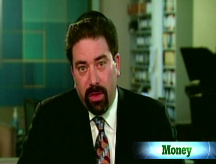Safe bets on bonds paying off
As stock index funds continue to lose money, Treasury bond investments are outperforming the equity market.
NEW YORK (CNNMoney.com) -- The mantra is "higher risk, higher reward," but the safest bets have given investors the most bang for their buck this year.
Finding little in the way of return on investment in other markets, investors have recently placed their bets on the Treasury market. Perceived to be the safest investments because they come with a backing from the U.S. government, Treasurys usually provide a low return on investment.
But as private investors, funds and foreign investors pour money into U.S. government bonds in a flight to safety, bonds have performed quite well this year.
The Lehman Brothers Aggregate U.S. Treasury index has returned 7.4% to investors so far since January, compared to a loss of more than 40% for S&P 500 stocks. In November alone, Treasurys returned 2.8% to investors, while S&P 500 investors lost 4.8%.
Recession fears and credit crisis anxiety have sent stocks falling in eight of 12 sessions thus far in November. Likewise, bonds have risen in eight of 11 sessions. The bond markets were closed on Veteran's Day, Nov. 11, while equities markets were open.
Even in days when stocks rise, such as Tuesday, recession fears have remained a top worry, sending bonds higher.
It's not just stocks that are faltering. Commodities are providing no safe haven either, as Lehman's energy commodity index has fallen 38% since January, and its precious metals index has fallen 32%.
Much of bonds' recent rise is due to a huge influx of foreign investors. According to Wachovia, the foreign private sector bought up nearly $126 billion of Treasurys in September, 71% of which were in short-term bonds that mature in less than a year.
Jay Bryson, an economist with Wachovia, said the foreign purchases of mainly short-term U.S. debt reflect the search for a safe haven. By contrast, U.S. investors scaled back their foreign investments for the third straight month in September, pulling out $35 billion of funds.
Bonds may continue to rise for a while, during a time in which a number of other economic indicators are expected to be disappointing. Pierre Ellis, senior economist at Decision Economics, said investors likely will continue to seek out Treasury investments while stocks look for a market bottom.
"Investors have a weak economic outlook, so they put what they have into safe assets," he said.
Bonds: Treasury prices again mostly moved higher Wednesday, as more dour economic data led investors to the perceived safety of government bonds.
A government report on inflation for the month of October showed consumer prices fell by 1%, the greatest decline on record. And a separate report showed housing starts and permits, key measurements of home construction, hit record lows in October.
The benchmark 10-year note rose 1-25/32 to 103-19/32, and its yield slipped to 3.33% from 3.54% late Tuesday. Bond prices and yields move in opposite directions.
The 2-year note rose 4/32 to 100-27/32, and its yield fell to 1.07% from 1.15%.
The benchmark yield curve, the difference between the 2-year and the 10-year yield, narrowed to 2.26 percentage points, down from a five-year high of 2.54 points set Friday. The yield curve is a key measure of investor sentiment, with a higher curve indicating a weaker economic environment.
The 30-year bond rose 3-20/32 to 110-5/32, and its yield fell to 3.92% from 4.12%.
The yield on the 3-month bill fell to 0.07% from 0.13%. The yield on the 3-month Treasury bill is closely watched as an immediate reading on investor confidence, with a lower yield indicating less optimism. Investors and money-market funds shuffle money into and out of the 3-month bill frequently as they assess risk in the rest of the marketplace.
Lending rates: The 3-month Libor rate fell Tuesday to 2.17% from 2.22%, and the overnight Libor rate rose to 0.44% from 0.40%, according to Bloomberg.com.
Libor, the London Interbank Offered Rate, is a daily average of interbank lending rates and a key barometer of liquidity in the credit market. More than $350 trillion in assets are tied to Libor.
Rates were mixed, as were two gauges of banks' confidence in the credit market.
The Libor-OIS spread was down to 1.71 from 1.76. The spread measures the difference between actual borrowing costs and the expected targeted borrowing rate from the Fed. It is used as a gauge to determine how much cash is available for lending between banks. The bigger the spread, the less cash is available for lending.
Another indicator, the TED spread, rose slightly to 2.10 percentage points from 2.09 points. The TED spread measures the difference between the 3-month Libor and the 3-month Treasury bill, and is a key indicator of risk. The lower the spread, the more willing investors are to take risks. ![]()




